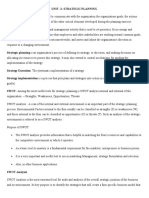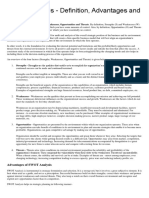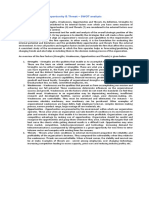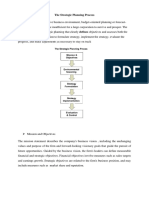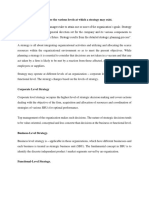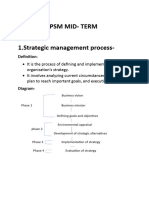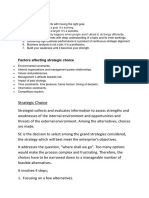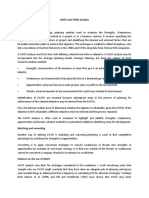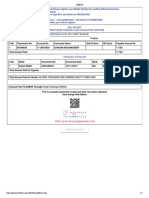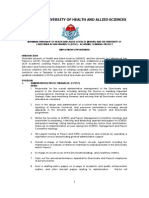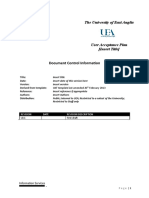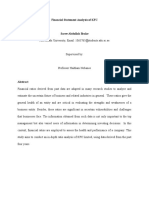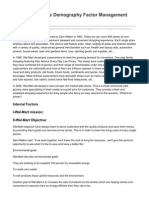Professional Documents
Culture Documents
Swot Def, Av PDF
Swot Def, Av PDF
Uploaded by
Caty TudoseOriginal Description:
Original Title
Copyright
Available Formats
Share this document
Did you find this document useful?
Is this content inappropriate?
Report this DocumentCopyright:
Available Formats
Swot Def, Av PDF
Swot Def, Av PDF
Uploaded by
Caty TudoseCopyright:
Available Formats
SWOT ANALYSIS
Definition, Advantages And Limitations:-
SWOT is an acronym for Strengths, Weaknesses, Opportunities and Threats. By
definition, Strengths (S) and Weaknesses (W) are considered to be internal factors over which
you have some measure of control. Also, by definition, Opportunities (O) and Threats (T) are
considered to be external factors over which you have essentially no control.
SWOT Analysis is the most renowned tool for audit and analysis of the overall strategic
position of the business and its environment. Its key purpose is to identify the strategies that
will create a firm specific business model that will best align an organization’s resources and
capabilities to the requirements of the environment in which the firm operates.
In other words, it is the foundation for evaluating the internal potential and limitations and the
probable/likely opportunities and threats from the external environment. It views all positive
and negative factors inside and outside the firm that affect the success. A consistent study of
the environment in which the firm operates helps in forecasting/predicting the changing
trends and also helps in including them in the decision-making process of the organization.
An overview of the four factors (Strengths, Weaknesses, Opportunities and Threats) is given
below-
1. Strengths - Strengths are the qualities that enable us to accomplish the organization’s
mission. These are the basis on which continued success can be made and
continued/sustained.
Strengths can be either tangible or intangible. These are what you are well-versed in
or what you have expertise in, the traits and qualities your employees possess
(individually and as a team) and the distinct features that give your organization its
consistency.
Strengths are the beneficial aspects of the organization or the capabilities of an
organization, which includes human competencies, process capabilities, financial
resources, products and services, customer goodwill and brand loyalty. Examples of
organizational strengths are huge financial resources, broad product line, no debt,
committed employees, etc.
2. Weaknesses - Weaknesses are the qualities that prevent us from accomplishing our
mission and achieving our full potential. These weaknesses deteriorate influences on
the organizational success and growth. Weaknesses are the factors which do not meet
the standards we feel they should meet.
13071A0241 SUKUMAR RATHOD
Weaknesses in an organization may be depreciating machinery, insufficient research
and development facilities, narrow product range, poor decision-making, etc.
Weaknesses are controllable. They must be minimized and eliminated. For instance -
to overcome obsolete machinery, new machinery can be purchased. Other examples
of organizational weaknesses are huge debts, high employee turnover, complex
decision making process, narrow product range, large wastage of raw materials, etc.
3. Opportunities - Opportunities are presented by the environment within which our
organization operates. These arise when an organization can take benefit of conditions
in its environment to plan and execute strategies that enable it to become more
profitable. Organizations can gain competitive advantage by making use of
opportunities.
Organization should be careful and recognize the opportunities and grasp them
whenever they arise. Selecting the targets that will best serve the clients while getting
desired results is a difficult task. Opportunities may arise from market, competition,
industry/government and technology. Increasing demand for telecommunications
accompanied by deregulation is a great opportunity for new firms to enter telecom
sector and compete with existing firms for revenue.
4. Threats - Threats arise when conditions in external environment jeopardize the
reliability and profitability of the organization’s business. They compound the
vulnerability when they relate to the weaknesses. Threats are uncontrollable. When a
threat comes, the stability and survival can be at stake. Examples of threats are -
unrest among employees; ever changing technology; increasing competition leading
to excess capacity, price wars and reducing industry profits; etc.
Advantages of SWOT Analysis
SWOT Analysis is instrumental in strategy formulation and selection. It is a strong tool, but it
involves a great subjective element. It is best when used as a guide, and not as a prescription.
Successful businesses build on their strengths, correct their weakness and protect against
internal weaknesses and external threats. They also keep a watch on their overall business
environment and recognize and exploit new opportunities faster than its competitors.
SWOT Analysis helps in strategic planning in following manner-
a. It is a source of information for strategic planning.
b. Builds organization’s strengths.
c. Reverse its weaknesses.
d. Maximize its response to opportunities.
e. Overcome organization’s threats.
f. It helps in identifying core competencies of the firm.
g. It helps in setting of objectives for strategic planning.
13071A0241 SUKUMAR RATHOD
h. It helps in knowing past, present and future so that by using past and current data,
future plans can be chalked out.
SWOT Analysis provide information that helps in synchronizing the firm’s resources and
capabilities with the competitive environment in which the firm operates.
SWOTANALYSISFRAMEWORK
Limitations of SWOT Analysis
SWOT Analysis is not free from its limitations. It may cause organizations to view
circumstances as very simple because of which the organizations might overlook certain key
strategic contact which may occur. Moreover, categorizing aspects as strengths, weaknesses,
opportunities and threats might be very subjective as there is great degree of uncertainty in
market. SWOT Analysis does stress upon the significance of these four aspects, but it does
not tell how an organization can identify these aspects for itself.
There are certain limitations of SWOT Analysis which are not in control of management.
These include-
a. Price increase;
b. Inputs/raw materials;
c. Government legislation;
d. Economic environment;
e. Searching a new market for the product which is not having overseas market due to
import restrictions; etc.
Internal limitations may include-
a. Insufficient research and development facilities;
b. Faulty products due to poor quality control;
c. Poor industrial relations;
d. Lack of skilled and efficient labour; etc
13071A0241 SUKUMAR RATHOD
Steps in Strategy Formulation Process:
Strategy formulation refers to the process of choosing the most appropriate course of action
for the realization of organizational goals and objectives and thereby achieving the
organizational vision. The process of strategy formulation basically involves six main
steps. Though these steps do not follow a rigid chronological order, however they are very
rational and can be easily followed in this order.
1. Setting Organizations’ objectives - The key component of any strategy statement is
to set the long-term objectives of the organization. It is known that strategy is
generally a medium for realization of organizational objectives. Objectives stress the
state of being there whereas Strategy stresses upon the process of reaching there.
Strategy includes both the fixation of objectives as well the medium to be used to
realize those objectives. Thus, strategy is a wider term which believes in the manner
of deployment of resources so as to achieve the objectives.
While fixing the organizational objectives, it is essential that the factors which
influence the selection of objectives must be analyzed before the selection of
objectives. Once the objectives and the factors influencing strategic decisions have
been determined, it is easy to take strategic decisions.
2. Evaluating the Organizational Environment - The next step is to evaluate the
general economic and industrial environment in which the organization operates. This
includes a review of the organizations competitive position. It is essential to conduct a
qualitative and quantitative review of an organizations existing product line. The
purpose of such a review is to make sure that the factors important for competitive
success in the market can be discovered so that the management can identify their
own strengths and weaknesses as well as their competitors’ strengths and weaknesses.
After identifying its strengths and weaknesses, an organization must keep a track of
competitors’ moves and actions so as to discover probable opportunities of threats to
its market or supply sources.
3. Setting Quantitative Targets - In this step, an organization must practically fix the
quantitative target values for some of the organizational objectives. The idea behind
this is to compare with long term customers, so as to evaluate the contribution that
might be made by various product zones or operating departments.
4. Aiming in context with the divisional plans - In this step, the contributions made by
each department or division or product category within the organization is identified
and accordingly strategic planning is done for each sub-unit. This requires a careful
analysis of macroeconomic trends.
5. Performance Analysis - Performance analysis includes discovering and analyzing
the gap between the planned or desired performance. A critical evaluation of the
organizations past performance, present condition and the desired future conditions
13071A0241 SUKUMAR RATHOD
must be done by the organization. This critical evaluation identifies the degree of gap
that persists between the actual reality and the long-term aspirations of the
organization. An attempt is made by the organization to estimate its probable future
condition if the current trends persist.
6. Choice of Strategy - This is the ultimate step in Strategy Formulation. The best
course of action is actually chosen after considering organizational goals,
organizational strengths, potential and limitations as well as the external
opportunities.
Steps in Strategy Formulation Process:
Strategy formulation refers to the process of choosing the most appropriate course of action
for the realization of organizational goals and objectives and thereby achieving the
organizational vision. The process of strategy formulation basically involves six main
steps. Though these steps do not follow a rigid chronological order, however they are very
rational and can be easily followed in this order.
1. Setting Organizations’ objectives - The key component of any strategy statement is
to set the long-term objectives of the organization. It is known that strategy is
generally a medium for realization of organizational objectives. Objectives stress the
state of being there whereas Strategy stresses upon the process of reaching there.
Strategy includes both the fixation of objectives as well the medium to be used to
realize those objectives. Thus, strategy is a wider term which believes in the manner
of deployment of resources so as to achieve the objectives.
While fixing the organizational objectives, it is essential that the factors which
influence the selection of objectives must be analyzed before the selection of
objectives. Once the objectives and the factors influencing strategic decisions have
been determined, it is easy to take strategic decisions.
2. Evaluating the Organizational Environment - The next step is to evaluate the
general economic and industrial environment in which the organization operates. This
includes a review of the organizations competitive position. It is essential to conduct a
qualitative and quantitative review of an organizations existing product line. The
purpose of such a review is to make sure that the factors important for competitive
success in the market can be discovered so that the management can identify their
own strengths and weaknesses as well as their competitors’ strengths and weaknesses.
After identifying its strengths and weaknesses, an organization must keep a track of
competitors’ moves and actions so as to discover probable opportunities of threats to
its market or supply sources.
13071A0241 SUKUMAR RATHOD
3. Setting Quantitative Targets - In this step, an organization must practically fix the
quantitative target values for some of the organizational objectives. The idea behind
this is to compare with long term customers, so as to evaluate the contribution that
might be made by various product zones or operating departments.
4. Aiming in context with the divisional plans - In this step, the contributions made by
each department or division or product category within the organization is identified
and accordingly strategic planning is done for each sub-unit. This requires a careful
analysis of macroeconomic trends.
5. Performance Analysis - Performance analysis includes discovering and analyzing
the gap between the planned or desired performance. A critical evaluation of the
organizations past performance, present condition and the desired future conditions
must be done by the organization. This critical evaluation identifies the degree of gap
that persists between the actual reality and the long-term aspirations of the
organization. An attempt is made by the organization to estimate its probable future
condition if the current trends persist.
6. Choice of Strategy - This is the ultimate step in Strategy Formulation. The best
course of action is actually chosen after considering organizational goals,
organizational strengths, potential and limitations as well as the external
opportunities.
Strategy Implementation - Meaning and
Steps in Implementing a Strategy
Strategy implementation is the translation of chosen strategy into organizational action
so as to achieve strategic goals and objectives. Strategy implementation is also defined as
the manner in which an organization should develop, utilize, and amalgamate organizational
structure, control systems, and culture to follow strategies that lead to competitive advantage
and a better performance. Organizational structure allocates special value developing tasks
and roles to the employees and states how these tasks and roles can be correlated so as
maximize efficiency, quality, and customer satisfaction-the pillars of competitive advantage.
But, organizational structure is not sufficient in itself to motivate the employees.
An organizational control system is also required. This control system equips managers with
motivational incentives for employees as well as feedback on employees and organizational
performance. Organizational culture refers to the specialized collection of values, attitudes,
norms and beliefs shared by organizational members and groups.
13071A0241 SUKUMAR RATHOD
Follwoing are the main steps in implementing a strategy:
Developing an organization having potential of carrying out strategy successfully.
Disbursement of abundant resources to strategy-essential activities.
Creating strategy-encouraging policies.
Employing best policies and programs for constant improvement.
Linking reward structure to accomplishment of results.
Making use of strategic leadership.
Excellently formulated strategies will fail if they are not properly implemented. Also, it is
essential to note that strategy implementation is not possible unless there is stability between
strategy and each organizational dimension such as organizational structure, reward structure,
resource-allocation process, etc.
Strategy implementation poses a threat to many managers and employees in an organization.
New power relationships are predicted and achieved. New groups (formal as well as
informal) are formed whose values, attitudes, beliefs and concerns may not be known. With
the change in power and status roles, the managers and employees may employ confrontation
behaviour.
13071A0241 SUKUMAR RATHOD
Strategy Formulation vs Strategy Implementation:
Following are the main differences between Strategy Formulation and Strategy
Implementation-
Strategy Formulation Strategy Implementation
Strategy Formulation includes planning and Strategy Implementation involves all those means
decision-making involved in developing related to executing the strategic plans.
organization’s strategic goals and plans.
In short, Strategy Formulation is placing the In short, Strategy Implementation is managing
Forces before the action. forces during the action.
Strategy Formulation is an Entrepreneurial Strategic Implementation is mainly an
Activity based on strategic decision-making. Administrative Task based on strategic and
operational decisions.
Strategy Formulation emphasizes on Strategy Implementation emphasizes on
effectiveness. efficiency.
Strategy Formulation is a rational process. Strategy Implementation is basically an
operational process.
Strategy Formulation requires co-ordination Strategy Implementation requires co-ordination
among few individuals. among many individuals.
Strategy Formulation requires a great deal of Strategy Implementation requires specific
initiative and logical skills. motivational and leadership traits.
Strategic Formulation precedes Strategy STrategy Implementation follows Strategy
Implementation. Formulation.
13071A0241 SUKUMAR RATHOD
You might also like
- Stock or Share Swap Agreement (Draft)Document11 pagesStock or Share Swap Agreement (Draft)Inquiry PVM100% (3)
- Disney: Sleeping Beauty BondsDocument3 pagesDisney: Sleeping Beauty Bondschamp10100% (1)
- The SWOT Analysis: A key tool for developing your business strategyFrom EverandThe SWOT Analysis: A key tool for developing your business strategyRating: 3.5 out of 5 stars3.5/5 (10)
- Communication of SWOTDocument8 pagesCommunication of SWOTCaty TudoseNo ratings yet
- Strategic Planning (Unit-2)Document14 pagesStrategic Planning (Unit-2)jalaja munirajuNo ratings yet
- Strategy ManagementDocument17 pagesStrategy Managementsubin100% (2)
- SWOT Analysis - Definition, Advantages and LimitationsDocument2 pagesSWOT Analysis - Definition, Advantages and LimitationsmackNo ratings yet
- What Are The Steps To Perform A Strategic Analysis?Document3 pagesWhat Are The Steps To Perform A Strategic Analysis?Fathi FathuNo ratings yet
- Strength Weakness Opportunity & Threat - SWOT AnalysisDocument3 pagesStrength Weakness Opportunity & Threat - SWOT AnalysisSurabhi Kapadekar100% (3)
- SM 2 UnitDocument27 pagesSM 2 UnitANKUR CHOUDHARYNo ratings yet
- Introduction of The Topic: SWOT Analysis (Alternatively SWOT Matrix) Is An Acronym For Strengths, WeaknessDocument59 pagesIntroduction of The Topic: SWOT Analysis (Alternatively SWOT Matrix) Is An Acronym For Strengths, WeaknessStarNo ratings yet
- SWOT AnalysisDocument4 pagesSWOT AnalysisNishu KatiyarNo ratings yet
- Strategic NotesDocument17 pagesStrategic NotesSaurabh KumarNo ratings yet
- CHA2 - Strategic MGMTDocument20 pagesCHA2 - Strategic MGMTAbdoul Shakour NeyaNo ratings yet
- Swot - STMDocument3 pagesSwot - STMrajeeevaNo ratings yet
- SwotDocument15 pagesSwotAdy Bayu PrakosoNo ratings yet
- BPSMDocument6 pagesBPSMSweta BastiaNo ratings yet
- UNIT-2: Environmental AppraisalDocument13 pagesUNIT-2: Environmental AppraisalVIVEK KUMAR SINGH 13No ratings yet
- The Strategic Planning ProcessDocument10 pagesThe Strategic Planning ProcessSyed Faiz QuadriNo ratings yet
- Q1 AssignmentDocument19 pagesQ1 AssignmentNeerajNo ratings yet
- Definition of Strategic ManagementDocument32 pagesDefinition of Strategic ManagementAmy ThompsonNo ratings yet
- SWOT Analysis: SWOT Is An Acronym For Strengths, Weaknesses, Opportunities and ThreatsDocument14 pagesSWOT Analysis: SWOT Is An Acronym For Strengths, Weaknesses, Opportunities and ThreatsAnonymous h6DhpqWA9No ratings yet
- NotesDocument12 pagesNotesPooja YadavNo ratings yet
- ManagementDocument7 pagesManagementbeshahashenafe20No ratings yet
- Strategic ManagementDocument11 pagesStrategic ManagementCrissa MorescaNo ratings yet
- BPSM MidDocument9 pagesBPSM MidShavya MohantyNo ratings yet
- SWOT AnalysisDocument7 pagesSWOT AnalysisNaveen Kishore GattimNo ratings yet
- Strategic Planning and Project ManagementDocument3 pagesStrategic Planning and Project Managementbtsvt1307 phNo ratings yet
- Essay Question MidDocument11 pagesEssay Question Midrbaalsdy530No ratings yet
- MMPC012Document5 pagesMMPC012210010502041.mgtNo ratings yet
- Strategic Management - Unit 2 & 3Document39 pagesStrategic Management - Unit 2 & 3Priyanshu Ranjan PandeyNo ratings yet
- LESSON 1: Environment AnalysisDocument10 pagesLESSON 1: Environment AnalysisApril Joy DelacruzNo ratings yet
- Operations StrategyDocument12 pagesOperations StrategyAblong Harold D.No ratings yet
- Chapter 1 StramanDocument6 pagesChapter 1 StramanAlain PayadNo ratings yet
- Sales and Distribution ManagementDocument2 pagesSales and Distribution ManagementPRACHI DASNo ratings yet
- Basic Planning ModelDocument8 pagesBasic Planning Modeljohnijala2No ratings yet
- Chapter 3Document11 pagesChapter 3Haaromsaa Taayyee TolasaaNo ratings yet
- Hul Final2Document34 pagesHul Final2Ahsan Abdul Rashid KhanNo ratings yet
- Topic IiDocument17 pagesTopic IiLianne PadillaNo ratings yet
- SM Note (AutoRecovered)Document21 pagesSM Note (AutoRecovered)yordanosgetahun887No ratings yet
- SWOT Analysis: - These Are The Qualities That Enable To Accomplish The Organization's Mission. TheseDocument3 pagesSWOT Analysis: - These Are The Qualities That Enable To Accomplish The Organization's Mission. TheseAlessandro MuragliaNo ratings yet
- Strama Reviewer CH 1-6Document10 pagesStrama Reviewer CH 1-6Christian AlceraNo ratings yet
- System ModelingDocument15 pagesSystem Modelingkaladevi210% (1)
- CS AssignmentDocument14 pagesCS AssignmentSamrin KhanNo ratings yet
- BA Interview QuestionsDocument87 pagesBA Interview QuestionsAravind ReddyNo ratings yet
- Strategy Management U123 NotesDocument7 pagesStrategy Management U123 NotesAdarsh DashNo ratings yet
- Unit 2Document43 pagesUnit 2Atul KumarNo ratings yet
- SM Module 1Document10 pagesSM Module 1Jeevan ManjunathNo ratings yet
- Recent Trends in SMDocument27 pagesRecent Trends in SMsurvishNo ratings yet
- H HHHH HHHH HHHH HHHHDocument9 pagesH HHHH HHHH HHHH HHHHAngelicaNo ratings yet
- A Study of Strategic MGMT On AmulDocument35 pagesA Study of Strategic MGMT On AmulDilshaad ShaikhNo ratings yet
- Topic:: Department of Management Sciences National University of Modern LanguagesDocument7 pagesTopic:: Department of Management Sciences National University of Modern LanguagesWazeeer AhmadNo ratings yet
- S Wort ProjectDocument37 pagesS Wort ProjectPari SavlaNo ratings yet
- SWOT Analysis For Entrepreneur - Theeranaipunya - ShinojDocument4 pagesSWOT Analysis For Entrepreneur - Theeranaipunya - ShinojRifa ZakiyaNo ratings yet
- Business DiagnosisDocument6 pagesBusiness DiagnosisEyob Light WorkuNo ratings yet
- SWOT Analysis: Navigation Search Strategic Planning Project Business Albert Humphrey Fortune 500Document6 pagesSWOT Analysis: Navigation Search Strategic Planning Project Business Albert Humphrey Fortune 500naifudeenNo ratings yet
- Swot Analysis and Its Use in Strategic Business PlanningDocument7 pagesSwot Analysis and Its Use in Strategic Business PlanningDivye SharmaNo ratings yet
- Strategic ManagementDocument4 pagesStrategic ManagementDK BalochNo ratings yet
- SHRMDocument10 pagesSHRMJames GikingoNo ratings yet
- SWOT Analysis: SWOT Analysis (Or SWOT Matrix) Is A Strategic Planning Technique Used To Help A Person orDocument6 pagesSWOT Analysis: SWOT Analysis (Or SWOT Matrix) Is A Strategic Planning Technique Used To Help A Person orАлинаОсадчук-ФердохлебNo ratings yet
- Bu Upik Swot PrintDocument10 pagesBu Upik Swot PrintKarina Ratna WidianiNo ratings yet
- Q1 Examine The Strategy Formulation Process in Detail.: Assignment 2Document10 pagesQ1 Examine The Strategy Formulation Process in Detail.: Assignment 2AbdullahNo ratings yet
- Applying The BCG Matrix To Analyze Egypt's Tourism Competitiveness PositionDocument22 pagesApplying The BCG Matrix To Analyze Egypt's Tourism Competitiveness PositionCaty TudoseNo ratings yet
- Derrick's Ice-Cream Company: Applying The BCG Matrix in Customer Profitability AnalysisDocument13 pagesDerrick's Ice-Cream Company: Applying The BCG Matrix in Customer Profitability AnalysisCaty TudoseNo ratings yet
- SWOTDocument3 pagesSWOTCaty TudoseNo ratings yet
- SWOT Analysis: August 2016Document16 pagesSWOT Analysis: August 2016Caty TudoseNo ratings yet
- Estimarea Cererii A: Data (One Step Transition Matrix)Document4 pagesEstimarea Cererii A: Data (One Step Transition Matrix)Caty TudoseNo ratings yet
- What's SWOT in Strategic Analysis?Document10 pagesWhat's SWOT in Strategic Analysis?Caty TudoseNo ratings yet
- Dariusz J Ropiak Impact of SWOT Analysis 2013Document4 pagesDariusz J Ropiak Impact of SWOT Analysis 2013Caty TudoseNo ratings yet
- Swot MethodologyDocument18 pagesSwot MethodologyCaty TudoseNo ratings yet
- PEST - and SWOT-analysis of University InternationaDocument7 pagesPEST - and SWOT-analysis of University InternationaCaty TudoseNo ratings yet
- The SWOT Analysis PDFDocument5 pagesThe SWOT Analysis PDFCaty TudoseNo ratings yet
- Swot MethodologyDocument27 pagesSwot MethodologyCaty TudoseNo ratings yet
- DHBVNDocument1 pageDHBVNvineet raoNo ratings yet
- Microeconomics Practice Problem Set #3: TC (Q) 20q TC (Q) 20q P (Q) 200 - QDocument3 pagesMicroeconomics Practice Problem Set #3: TC (Q) 20q TC (Q) 20q P (Q) 200 - QsanNo ratings yet
- TOPIC 3 Seeking, Screening, and Seizing OpportunitiesDocument21 pagesTOPIC 3 Seeking, Screening, and Seizing OpportunitiesShadow ReaperNo ratings yet
- 4 FIN555 Chap 4 Prings Typical Parameters For Intermediate Trend (Recovered)Document16 pages4 FIN555 Chap 4 Prings Typical Parameters For Intermediate Trend (Recovered)Najwa SulaimanNo ratings yet
- Group 10 - Capital FloatDocument19 pagesGroup 10 - Capital FloatAnonymous V2hyzY1axNo ratings yet
- Supervisors - and - Managers - Safety - Audit - Training v.3.3Document44 pagesSupervisors - and - Managers - Safety - Audit - Training v.3.3Mohamed LotfiNo ratings yet
- Ap02-01 Audit of SheDocument6 pagesAp02-01 Audit of SheRenato OrosaNo ratings yet
- UCSF-MUHAS Vacancy AdvertDocument12 pagesUCSF-MUHAS Vacancy AdvertSubi100% (3)
- Session 1 - Marketing Business Analytics - 0621Document68 pagesSession 1 - Marketing Business Analytics - 0621Deepak PurohitNo ratings yet
- User Acceptance TestDocument7 pagesUser Acceptance Testsuntm100% (1)
- Rescheduled Time Table November 2023Document19 pagesRescheduled Time Table November 2023Priyadharshini RNo ratings yet
- Marketing Management QuizDocument37 pagesMarketing Management QuizShah HossainNo ratings yet
- Avelina Ramoso Et Al Vs Court of AppealsDocument1 pageAvelina Ramoso Et Al Vs Court of AppealsAnonymous oDPxEkdNo ratings yet
- Marketing Research PepsiDocument9 pagesMarketing Research Pepsivishusuni100% (1)
- Financial Statement Analysis of KFCDocument15 pagesFinancial Statement Analysis of KFCPrasiddha PradhanNo ratings yet
- GE2022 2 Marks PDFDocument23 pagesGE2022 2 Marks PDFsudharsonkumarNo ratings yet
- Kcatc Kasneb Fee StructureDocument5 pagesKcatc Kasneb Fee StructureInterofficeNo ratings yet
- Staffing 100 Staffing Industry Review PDFDocument19 pagesStaffing 100 Staffing Industry Review PDFLate ArtistNo ratings yet
- Financial Statements 2020 2021: Error Error Error Error ErrorDocument8 pagesFinancial Statements 2020 2021: Error Error Error Error ErrorSudhanshu Kumar SinghNo ratings yet
- Chapter 30 Cost AuditDocument5 pagesChapter 30 Cost AuditRajesh TncNo ratings yet
- Document 1995 3714Document34 pagesDocument 1995 3714doctorsantalumu9coabNo ratings yet
- HRM TpeDocument12 pagesHRM TpeTesfayé HailuNo ratings yet
- Isak 35Document10 pagesIsak 35Lusi AnggrainiNo ratings yet
- Chapter 6 Notes - Sustaining and Rejuvenating BrandsDocument4 pagesChapter 6 Notes - Sustaining and Rejuvenating Brandssmpbl11.vikrampNo ratings yet
- Assignment Fin AccDocument4 pagesAssignment Fin AccShaira SalandaNo ratings yet
- Wal Mart and The Demography Factor Management EssayDocument8 pagesWal Mart and The Demography Factor Management EssayGPNo ratings yet
- BIR Ruling No. 253-16Document4 pagesBIR Ruling No. 253-16john allen MarillaNo ratings yet
- E-Government Drives ProductivityDocument16 pagesE-Government Drives ProductivityDokumen siapa iniNo ratings yet





